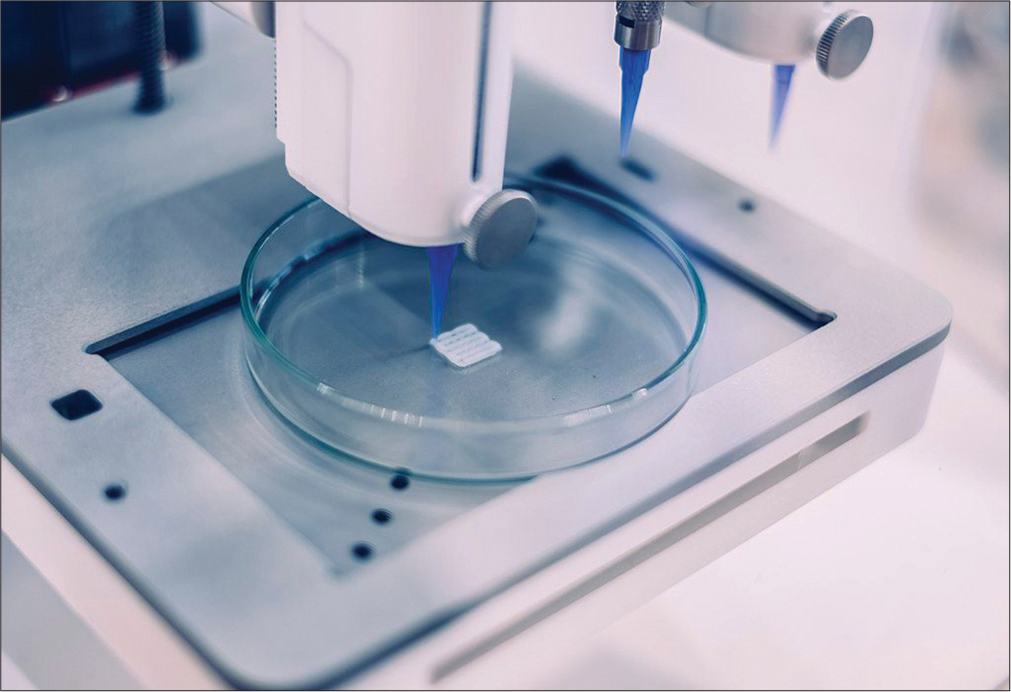Translate this page into:
3D-printed hair follicles – A new era in hair loss treatments

*Corresponding author: Muhammad Umar, Khairpur Medical College, Khairpur Mirs, Pakistan. umar60560@gmail.com
-
Received: ,
Accepted: ,
How to cite this article: Umar M, Ali Z, Shoaib F, Mohamed W. 3D-printed hair follicles – A new era in hair loss treatments. CosmoDerma. 2024;4:106. doi: 10.25259/CSDM_77_2024
Dear Sir,
I am writing to shed light on progressive advances in hair loss treatments that have been oriented up to date. Hair loss is a prevalent condition that can have both physical and psychological ramifications. Individuals experiencing various forms of alopecia often seek hair regeneration. Androgenetic alopecia, alopecia areata, and telogen effluvium are among the diverse types of hair loss observed.[1] Conventional treatment modalities encompass minoxidil, finasteride, hair transplant, plasma cell therapy, micro-needling, and stem cell therapy; however, they are associated with certain limitations. In recent years, there has been substantial research into the biology of hair follicles (HFs) due to their significance in dermatology and their role as a point of entry for cosmetics and specific medications.[2]
The 3D printing process involves cultivating skin and follicle cells in a controlled laboratory setting, facilitating the proliferation of these cells, and combining them with proteins and biomaterials to create a “bio-ink” for the 3D printer.[3] The 3D printing model aids in hair transplantation by creating artificial hair follicles using cultured skin and follicle cells. This approach can overcome the limitations of conventional hair transplantation, particularly in cases where there are inadequate donor sites. By generating hair follicles in a controlled laboratory setting, 3D printing provides a reliable and potentially unlimited source of hair grafts, which can significantly enhance patient satisfaction and outcomes in hair transplantation procedures.[4] The isolation process spans approximately two weeks, while cultivation and expansion take about one to four weeks. Subsequently, the bioink is loaded into bioprinting equipment and deposited layer by layer using a fine needle, creating skin and hair cell channels. Over time, the skin cells migrate into the channels, mimicking natural HFs. A preprogrammed algorithm guides the deposition of materials, resulting in three-dimensional tissue creation. The printing process commences with the deposition of the bottommost layer (dermis). Once the dermis solidifies, the printer proceeds to create the HFs and the outer layer of the skin (epidermis). This entire printing process for 12 samples, each approximately one inch in diameter, typically takes around one hour. Following printing, the samples are placed in a controlled environment for incubation, with regular media changes to maintain optimal temperature and carbon dioxide levels which last for two weeks and allow the tissue to mature. The printed skin samples are then ready for in vitro evaluations of substances, marking a significant advancement in tissue engineering. However, the bio-printed tissues can only survive for a couple of weeks, which is insufficient for full hair development.[3]
A new technology in 3D bioprinting is the creation of automated methods that could make the engineering of complex tissues easier [Figure 1]. The 3D bioprinting makes it possible to precisely position materials and cells to produce complex structures that follow predetermined patterns in a high-throughput, repeatable manner.[3,5]

- The procedure of 3D printing hair follicles taken from a Creative Commons data set and is free to use for everyone. This illustration provides a visual representation of the intricate process involved in creating artificial hair follicles through 3D bioprinting, aiding readers in comprehending the detailed methodology.
The 3D printing holds significant promise in the realms of regenerative medicine and pharmaceutical testing. It can facilitate the advancement of biological tissue, create complex skin structures, and serve as a screening tool for identifying toxic substances affecting HF cells. This emerging technology has the potential to revolutionize the generation of complex skin models, impacting material arrangement and cell-to-cell structures. It offers exciting opportunities for hair regeneration and influences safety and efficacy assessments in the pharmaceutical, cosmetic, and regenerative medicine industries. Further, research is crucial for its application in skin grafting and drug testing.[2,6] One of the primary drawbacks of the 3D printing model for hair follicle generation is the associated cancer risk. Pluripotent stem cells, which are crucial for regenerative therapies, have genetic connections with oncogenesis, posing a potential risk of cancer development. Therefore, while 3D bioprinting holds great promise, it is essential to conduct thorough research to mitigate these risks before widespread clinical application.
Ethical approval
The Institutional Review Board approval is not required.
Declaration of patient consent
Patient’s consent was not required as there are no patients in this study.
Conflicts of interest
There are no conflicts of interest.
Use of artificial intelligence (AI)-assisted technology for manuscript preparation
The authors confirm that there was no use of artificial intelligence (AI)-assisted technology for assisting in the writing or editing of the manuscript and no images were manipulated using AI.
Financial support and sponsorship
Nil.
References
- Status of research on the development and regeneration of hair follicles. Int J Med Sci. 2024;21:80-94.
- [CrossRef] [PubMed] [Google Scholar]
- 3D printing of microneedle arrays for hair regeneration in a controllable region. Mol Biomed. 2023;4:1.
- [CrossRef] [PubMed] [Google Scholar]
- Incorporation of hair follicles in 3D bioprinted models of human skin. Sci Adv. 2023;9:eadg0297.
- [CrossRef] [PubMed] [Google Scholar]
- Scientists 3D-print hair follicles in lab-grown skin. 2023. Practical Dermatology. Available from: https://practicaldermatology.com/news/scientists-3d-print-hair-follicles-in-lab-grown-skin/2462137 [Last accessed on 2024 Jul 29]
- [Google Scholar]
- Photo by Philip Ezze. CC BY-SA 4.0. Available from: https://creativecommons.org/licenses/by-sa/4.0 [Last accessed on 2024 Jul 29]
- [Google Scholar]
- The promising prospect of human hair follicle regeneration in the shadow of new tissue engineering strategies. Tissue Cell. 2024;87:102338.
- [CrossRef] [PubMed] [Google Scholar]






